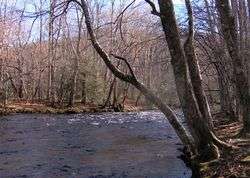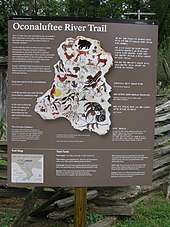Oconaluftee River
The Oconaluftee River[4] drains the south-central Oconaluftee valley of the Great Smoky Mountains in North Carolina before emptying into the Tuckasegee River. The river flows through the Qualla Boundary, a federal land trust that acts as a reservation for the Eastern Band of the Cherokee.
| Oconaluftee River Egwanulti | |
|---|---|
 View of the Oconaluftee River within the Great Smoky Mountains National Park | |
| Native name | Ocona Luftee;[1] Oconalufty[2] |
| Location | |
| Country | United States |
| State | North Carolina |
| Physical characteristics | |
| Source | Beech Flats Prong |
| Mouth | |
• location | Tuckasegee River |
• coordinates | 35°58′7″N 83°36′15″W |
| Length | 30 mi (48 km) |
| Discharge | |
| • location | Birdtown |
| • average | 518 cu ft/s (14.7 m3/s)[3] |
| Basin features | |
| River system | Tuckasegee → Little Tennessee → Tennessee → Ohio → Mississippi |
Geology
Beech Flats Prong is a stream formed by the convergence of several spring outlets high in the Appalachians near Newfound Gap, a mountain pass that straddles the Tennessee–North Carolina border in the center of the Great Smoky Mountains National Park. The creek flows about 10 miles (16 km) south where it merges with Smith Branch, Kepharts Prong, and the Kanati Fork to form the Oconaluftee River. The river continues south, where it is joined by the Bradley Fork, greatly strengthening its flow. A large, flat bottomland is created by the river's confluence with the Raven Fork at Cherokee, where the river turns westward, flowing to its mouth on the Tuckasegee River, near Bryson City in Swain County, North Carolina.[5] The Oconaluftee passes through the settlements of Smokemount, the Oconaluftee Village and Hospital, the town of Cherokee, Indian Hills, and Birdtown before emptying into the Tuckasegee.
History

The Cherokee people considered the Ocona Luftee waters to be sacred.[6] The name, "Ocona Luftee" was derived from the name of the Cherokee village, "Egwanulti," which was erected on its banks prior to the area's colonization by European frontiersmen. The name translates to "by the river" in English.[7] The river, and the village, pre-dates the arrival to the area of early scientific explorer, John Bartram.[8]
During the time of the Indian removals, the Cherokee who lived on private lands which had been individually purchased were not subject to removal. About 500 Cherokee led by Yonaguska lived on land along the Oconaluftee which was owned by a white man in trust for the Cherokee, to protect it for them. William Holland Thomas had been adopted by Cherokee as a boy, and therefore this band of Cherokee could remain, safe from removal. These were joined by a smaller band of about 150 who lived along the Nantahala River led by Utsala. Other groups living in Snowbird and along the Cheoah River (in Tomotley) also stayed. If needed, they could all gather on the land held in trust by Thomas, and be safe. These are today the Eastern Band of the Cherokee Nation, numbering approximately 2000. In the 1870s, the people expanded their lands with the purchase of the Qualla Boundary.
Research
Prolific areas of archeological remains are found especially in the flat bottom lands about the mouth of Mingus creek, Toe String creek, Bradley Fork, and Collins creek.[9]
| Wikimedia Commons has media related to Oconaluftee River. |
Notes
- Powell, William S.; The North Carolina Gazetteer; Chapel Hill, North Carolina: University of North Carolina Press; [1968].
- U.S. Board on Geographic Names. Geographic Names Post Phase I Board/Staff Revisions. 01-Jan-2000. Board decisions referenced after Phase I data compilation or staff researched non-controversial names.
- https://waterdata.usgs.gov/nc/nwis/annual/?format=sites_selection_links&search_site_no=03512000&agency_cd=USGS&referred_module=sw
- "Oconaluftee River". Geographic Names Information System. United States Geological Survey. Retrieved 2019-08-28.
- Oconaluftee River; GeoNames; US gov on-line; accessed August 2019
- Bush, Florence Cope; Dorie: Woman of the Mountains; Knoxville: University of Tennessee Press; (1992); ISBN 978-0870497261
- Bright, William (2004). Native American Placenames of the United States. University of Oklahoma Press. ISBN 978-0-8061-3598-4. Retrieved 12 August 2019.
- Mooney, James, Myths of the Cherokee; From Nineteenth Annual Report of the Bureau of American Ethnology 1897-98, Part I. [1900]; ISBN 978-0486289076;
- Southern Indian Studies, vol. 2 - No. 2; Wood, William; Wilburn, Hiram; Archeological Society of North Carolina and The Laboratory of Anthropology & Archeology [at] The University of North Carolina; Chapel Hill; (October 1950); pdf download